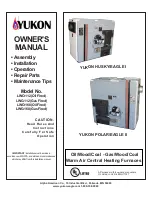
11
horizontal position and the face of the damper vertical for
proper functioning (see instructions included with the damper.)
After the furnace has been firing for at least five minutes, the
draft regulator should be set to between -0.025" and -0.060"
W.C.
3.3.5 Overfire Pressure Test
The overfire draft that is taken through the observation port,
located above the burner, is a measurement necessary to
determine if there is a blockage in the heat exchanger or the
flue pipe. Refer to the Technical Specifications in this manual
for overfire pressure values. A high pressure condition may be
caused by excessive combustion air, due to the air band being
too wide open, or a lack of flue draft (chimney effect) or some
other blockage, such as soot in the secondary section of the
heat exchanger or the use of an oversize nozzle input or high
pressure pump.
3.3.6 Vent Temperature Test
1.
After having adjusted the burner combustion, insert a
thermometer into the test hole in the breech pipe;
2.
The total vent temperature should be between 204 and
302°C (400 and 575°F). If not, check for improper air
temperature rise, pump pressure, nozzle size or a badly
sooted heat exchanger.
3.3.7 Supply Air Temperature Rise Test
1.
Operate the burner for at least 10 minutes;
2.
Measure the air temperature in the return air plenum;
3.
Measuring the air temperature in the largest trunk coming
off the supply air plenum, just outside the range of radiant
heat from the heat exchanger. 0.3 m (12") from the
plenum of the main take-off is usually sufficient;
4.
The temperature rise is calculated by subtracting the
return air temperature from the supply air temperature;
5.
If the temperature rise is lower or exceeds the
temperature specified in Table 6, change to the next lower
or higher blower speed tap, until the temperature rise falls
to the target. If the excessive temperature rise cannot be
increased or reduced by changing fan speed, investigate
for ductwork obstructions, dirty or improper air filter,
improper firing caused by improper pump pressure or
nozzle sizing.
3.3.8 Limit Control Check
After operating the furnace for at least 15 minutes, restrict the
return air supply by blocking the filters or the return air register
and allow the furnace to shut off on High Limit. The burner will
shut off but the blower will continue to run.
Remove the obstruction and the burner should restart after a
few minutes. The time required for the restart also depends on
the adjustment of the blower “OFF” delay.
3.3.9 Restart After Burner Failure
1.
Set the thermostat lower than room temperature;
2.
Press the reset button on the burner primary control
(relay);
3.
Set the thermostat higher than room temperature;
4.
If the burner motor does not start or ignition fails, turn off
the disconnect switch and CALL A QUALIFIED SERVICE
TECHNICIAN.
CAUTION
Do not attempt to start the burner when excess oil has
accumulated, when the furnace is full of vapour or when
the combustion chamber is hot.
4 MAINTENANCE
WARNING
Electrical shock hazard.
Turn OFF power and fuel to the furnace before any
disassembly or servicing.
Failure to do so can result in death, bodily injury
and/or property damage.
Preventive maintenance is the best way to avoid
unnecessary expense and inconvenience. Have your
heating system and burner inspected by a qualified
service technician at regular intervals.
To maintain the reliability and optimal performance of the
furnace, have a complete combustion check done after
the annual maintenance call. Do not attempt to repair the
furnace or its controls. Call a qualified service technician.
Before calling for repair service check the following points:
1. Check the oil tank gauge and make sure that the
valve is open;
2. Check fuses and the circuit breaker;
3. Check if the main disconnect switch is ON ;
4. Set the thermostat above room temperature;
5. If ignition does not occur, turn off the disconnect
switch and call a qualified service technician.
When ordering replacement parts, please specify the
complete furnace model number and serial number.
4.1 CLEANING
THE
HEAT
EXCHANGER
It is not generally necessary to clean the heat exchanger
or flue pipe every year, but it is advisable to have the oil
burner service technician check the unit before each
heating season to determine whether the cleaning or
replacement of parts is necessary.
If a cleaning is necessary, the following steps should be
performed:
1. Turn OFF all utilities upstream from the furnace;
2. Disconnect the flue pipe;
3. Remove the flue collar panel located at the front of
the furnace;
4. Remove the heat exchanger baffles;
5. Disconnect the oil line and remove the oil burner;
6. Clean the secondary tubes and the primary cylinder
with a stiff brush and a vacuum cleaner;
7. Before re-assembling the unit, the heat exchanger
and combustion chamber should be inspected to
determine if replacement is required;
Содержание AMP112SD
Страница 17: ...17 Figure 9 Furnace Dimensions...
Страница 18: ...18 Figure 10 Wiring Diagram 4 Speed Motor PSC...
Страница 19: ...19 Figure 11 Wiring Diagram Variable Speed Motor ECM...
Страница 20: ...20 Figure 12 Parts list with 4 speed motor PSC B50091C...
Страница 22: ...22 Figure 13 Parts list with variable speed motor ECM B50092C...
Страница 25: ......
Страница 42: ...19 Figure 9 Dimensions de la fournaise...
Страница 43: ...20 Figure 10 Diagramme lectrique avec moteur 4 vitesses PSC...
Страница 44: ...21 Figure 11 Diagramme lectrique avec moteur vitesse variable ECM...
Страница 45: ...22 B50091C Figure 12 Liste de pi ces avec moteur 4 vitesses PSC...
Страница 47: ...24 B50092C Figure 13 Liste de pi ces avec moteur vitesse variable ECM...












































